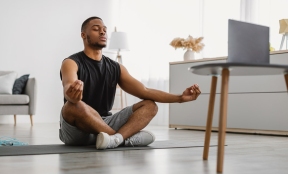Whether you have a home office or have created a makeshift office, it is important to make sure that it is set up in a way that does not negatively affect your posture. Ergonomics play a huge part in making your at home work space posture approved.
The term workplace ergonomics refers to creating a workspace that removes risk factors that lead to musculoskeletal injuries. Implementing ergonomics into your office also allows for improved performance and productivity.
One common injury that has been increasing from poor posture due to ergonomics is “tech neck.” This is a medical condition that can cause ongoing neck pain in people that spend most of their day looking down at a phone, tablet, or computer. “Looking downward for lengths of time can lead to the weakening of some muscles in the neck or the tightening of other muscles,” explains Joe Castronovo, PT, DPT, MTC, IBJI’s Industrial Rehabilitation Manager.
“Bad posture can definitely have some long term effects that lead to early degenerative disc diseases and the narrowing of the spinal cord,” he says.
The good news is that there are things you can do while working from home to improve your workspace ergonomics and combat poor posture.
Castronovo says the three things you need are, “good lumbar support, good lighting and keeping the screen at eye level."

Castronovo recommends to keep your screen at eye level. "The Lighting Judge/Shutterstock.com"
Keeping your screen at eye level is one of the most important things you can do when setting up a home office. It keeps you from sloping your head forward or bending your neck down both of which are bad for posture. If you don’t have a proper work space, you can substitute this by using a kitchen table. If the table is not high enough, you can prop your device up with the use of other objects such as books. Ensure that the objects you use to prop up your device are sturdy and will not fall.
Another great option that you can implement at home is a stand up desk. Standing desks are said to have a variety of health benefits, one of which is reduced back pain. If you’re interested in trying this but do not have a standing desk, you can recreate this by working on higher countertops.
Additionally, Castronovo says it is important to take breaks while working. During these breaks you should do simple exercises and stretch your muscles.
Practice this advice while working from home, to avoid pain caused by a poor posture.
Making simple adjustments like the above mentioned can help to decrease the risk of musculoskeletal injury caused by poor posture. If you are uncomfortable while working, make the necessary changes to get comfortable. A simple change like having a screen at eye level can make all the difference!




